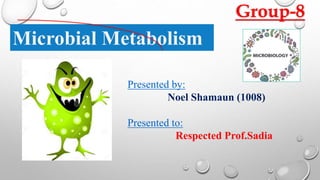
Micobial metabolism
- 1. Microbial Metabolism Presented by: Noel Shamaun (1008) Presented to: Respected Prof.Sadia Group-8
- 2. MICROBES Microbes are microorganisms which means they cannot be seen with the naked eye and we use microscope to see and observe them. Examples: Bacteria, archaea, and single cell, amoeba or a paramecium. Sometimes we call viruses microbes too.
- 3. Introduction of Microbial Metabolism The term metabolism denotes all chemical reactions & physical workings occurring in a cell. Energy production from metabolism helps a bacterial cell to be extensive and varied. Energy which produces from metabolism system is required for synthesis of enzymes, nucleic acids, polysaccharides and other chemical components. Energy is also required for repair damage of cell.
- 4. Metabolism Metabolism is the chemical reaction and it is the use of body cell which breaks food into energy and then this energy will be used by the body to move and grow and this chemical reaction is controlled by specific proteins. There are two types of metabolism: Metabolism Anabolism Catabolism
- 5. Types of Metabolism Catabolism A building and bond-making process that forms larger macromolecules from smaller ones. Requires the input of energy stored in the bonds of ATP. Examples; Catabolic processes are proteins becoming amino acids, glycogen breaking down into glucose and triglycerides breaking up into fatty acids. Anabolism Breaks the bonds of larger molecules into smaller molecules. Release energy. Examples; Include the formation of polypeptides from amino acids, glucose forming glycogen and fatty acids forming triglycerides.
- 6. Types of Microbial Metabolism All microbial metabolisms can be arranged according to: Autotrophs: An autotroph is an organism that can produce its own food using light, water, carbon dioxide, or other chemicals. Examples of autotrophs include plants, algae, plankton and bacteria. Heterotrophs: A heterotroph is an organism that eats other plants or animals for energy and nutrients. Dogs, birds, fish, and humans are all examples of heterotrophs. Phototrophs: An organism, typically a plant, obtaining energy from sunlight as its source of energy to convert inorganic materials into organic materials for use in cellular functions such as biosynthesis and respiration. These organisms are purple non-sulfur bacteria, green non-sulfur bacteria, and heliobacteria
- 7. Chemotrophs: Chemotrophs obtain their energy from chemicals (organic and inorganic compounds). They include organisms that use chemical reaction to obtain energy. Lithotrophs: Lithotrophs are a diverse group of organisms using an inorganic substrate to obtain reducing equivalents for use in biosynthesis or energy conservation via aerobic or anaerobic respiration. Organotrophs: An organotroph is an organism that obtains hydrogen or electrons from organic substrates.
- 8. Enzymes Enzymes are proteins that act as biological catalysts. Catalysts accelerate chemical reactions. The molecules upon which enzymes may act are called substrates. Enzyme converts the substrates into different molecules known as products They have a globular shape. A complex 3-D structure.
- 9. Transfer reaction of enzyme Oxidation-reduction reactions: Transfer of electrons. Aminotransferases: Convert one type of amino acid to another by transferring an amino group. Phosphotransferases: Transfer phosphate groups, involved in energy transfer. Methyltransferases: Move methyl groups from one molecule to another. Decarboxylases: Remove carbon dioxide from organic acids.
- 10. Fermentation Fermentation is a specific type of heterotrophic metabolism that uses organic carbon instead of oxygen as a terminal electron acceptor. In the absence of aerobic or anerobic respiration, NADH is not oxidized by the ETC. This is because no external electron acceptor is available. But to continue the metabolism, NAD must be regenerated. In such situations, microorganisms do not convert pyruvate into Acetyl - CoA. Instead, they use pyruvate or its derivatives as an electron acceptor for reoxidation of NADH. It also leads to production of ATP. The lactic fermentation is a typical example: Bacteria produce energy by fermentation. Streptococcus lactis.
- 11. Glycolytic pathway The pathway is also known as Embden–Meyerhof–Parnas(EMP) pathway. It is the common pathway for glucose degradation to pyruvate and is found in animals, plants and large number of microorganism. This pathway is used by anaerobic as well as aerobic organisms. The process takes place in the cytoplasm of prokaryotes and eukaryotes. The pathway consists of ten enzyme- catalyzed reactions that begin with a glucose molecule. These reactions comprise three stages: Conversion of glucose into fructose 1,6 - bisphosphate Splitting of the fructose 1-6- bisphosphate into two three- carbon fragments. The formation of pyruvate along with ATP generation.
- 14. Krebs's cycle The Kreb's cycle is named after its discoverer, British scientist Hans Adolf Krebs (1900–1981). Kreb's Cycle also called; Citric acid cycle Tricarboxylic acid cycle (TCA).
- 15. Kreb's cycle Process The Krebs cycle takes place in the cytoplasm of bacteria and in the mitochondrial matrix of eukaryotes: Transfers the energy stored in acetyl CoA to NAD+ and FAD by reducing them (transferring hydrogen ions to them). NADH and FADH2 carry electrons to the electron transport chain. Two ATPs are produced for each molecule of glucose through phosphorylation. Along the way, acetyl CoA, which joins with oxaloacetic acid, and then participates in seven other additional transformations.
- 17. Nitrogen cycle The nitrogen cycle is the process by which nitrogen is converted between its various chemical forms. This transformation can be carried out through both biological and physical processes. Jules Reiset recognized in 1856 that decaying organic matter releases nitrogen. This discovery ultimately provided the basis for the nitrogen cycle because it was the first evidence of nitrogen cycling in the biological sphere.
- 18. Nitrogen cycle Nitrogen Cycle Nitrogen cycle consists of the following steps: Nitrogen Fixation Nitrogen assimilation Ammonification Nitrification Denitrification.